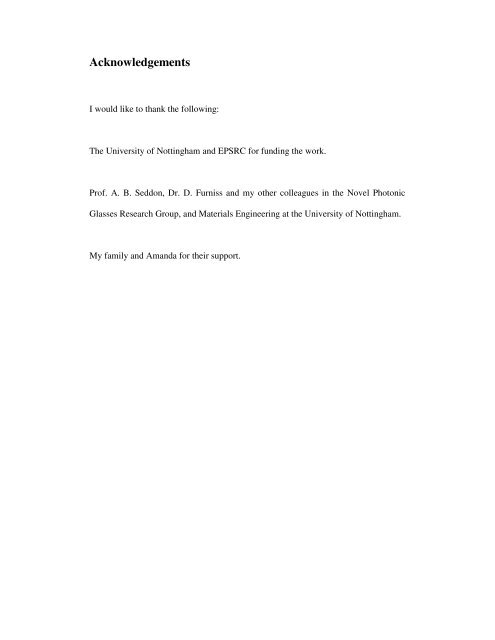Tellurite And Fluorotellurite Glasses For Active And Passive
Tellurite And Fluorotellurite Glasses For Active And Passive Tellurite And Fluorotellurite Glasses For Active And Passive
Acknowledgements I would like to thank the following: The University of Nottingham and EPSRC for funding the work. Prof. A. B. Seddon, Dr. D. Furniss and my other colleagues in the Novel Photonic Glasses Research Group, and Materials Engineering at the University of Nottingham. My family and Amanda for their support.
Abstract Glasses systems based on TeO2-ZnO-Na2O (TZN), TeO2-WO3, and TeO2-Na2O-ZnF2 are reported here, with a number of other components added (PbO, GeO2, Nb2O5, Bi2O3, Er2O3, Yb2O3, PbF2, and ErF3). Glass formation was shown for the first time, to this author’s knowledge, in the ternary system (90-x)TeO2-10Na2O-xZnF2 for 5 ≤ x ≤ 30 mol. %. Glass stability (Tx-Tg) was found to increase with ZnF2 addition, reaching a plateau of around 161°C at x = 25 mol. %. This could be due to competition of various phases to crystallise (NaZnF3 and Zn2Te3O8) as the eutectic is approached, with fluoride addition. These glasses are the most stable ZnF2 containing tellurite compositions reported to date, to the author’s knowledge. As-received ZnF2 batch material was shown to contain a significant proportion of Zn(OH)F, identified by XRD. The as-received ZnF2 was fluorinated with (NH4)HF2, which produced a substantially more phase pure powder, with oxygen levels reduced from around 13.2 to 3.1 at. % from XPS spectra. By calculation from the O1s XPS peaks, the proportion of Zn(OH)F was reduced in the powders from 39.7 to 9.4 mol. %. A number of absorption bands in the infrared were identified by FTIR for the TeO2 - ZnO-Na2O glasses due to intrinsic lattice vibrations (visible in a 0.2 mm sample), and extrinsic impurity absorption, including: free OH (≈ 3.0 µm ≡ 3300 cm -1 ), weakly hydrogen-bonded OH (≈ 3.3 µm ≡ 3060 cm -1 ), and strongly hydrogen-bonded OH (≈ 4.8 µm ≡ 2090 cm -1 ).
- Page 1: TELLURITE AND FLUOROTELLURITE GLASS
- Page 5 and 6: Contents; MDO i Contents Contents i
- Page 7 and 8: Contents; MDO iii 6.1.2.1. Method a
- Page 9 and 10: Glossary; MDO Glossary aM = partial
- Page 11 and 12: Glossary; MDO λ = wavelength λn =
- Page 13 and 14: Glossary; MDO Ψ = complex dielectr
- Page 15 and 16: 1. Introduction; MDO 2 communicatio
- Page 17 and 18: 1. Introduction; MDO 4 Infrared tra
- Page 19 and 20: 1. Introduction; MDO 6 1.4. Thesis
- Page 21 and 22: 1. Introduction; MDO 8 [14] J. E. S
- Page 23 and 24: 2. Literature review; MDO 10 one of
- Page 25 and 26: 2. Literature review; MDO 12 superc
- Page 27 and 28: 2. Literature review; MDO 14 2.2.2.
- Page 29 and 30: 2. Literature review; MDO 16 phenom
- Page 31 and 32: 2. Literature review; MDO 18 tenden
- Page 33 and 34: 2. Literature review; MDO 20 crysta
- Page 35 and 36: 2. Literature review; MDO 22 the Za
- Page 37 and 38: 2. Literature review; MDO 24 2.3.2.
- Page 39 and 40: 2. Literature review; MDO 26 Champa
- Page 41 and 42: 2. Literature review; MDO 28 the ad
- Page 43 and 44: 2. Literature review; MDO 30 (a) (b
- Page 45 and 46: 2. Literature review; MDO 32 showed
- Page 47 and 48: 2. Literature review; MDO 34 absorp
- Page 49 and 50: 2. Literature review; MDO 36 sharp
- Page 51 and 52: 2. Literature review; MDO 38 near f
Acknowledgements<br />
I would like to thank the following:<br />
The University of Nottingham and EPSRC for funding the work.<br />
Prof. A. B. Seddon, Dr. D. Furniss and my other colleagues in the Novel Photonic<br />
<strong>Glasses</strong> Research Group, and Materials Engineering at the University of Nottingham.<br />
My family and Amanda for their support.



